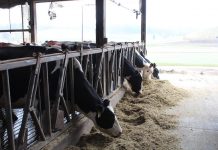I had the privilege of traveling overseas to conduct research during part of the summer, so I missed all of the hot and dry weather during July. Using the Internet, I could follow the ongoing drama of the rain that never showed.
But one can never appreciate the devastation until one sees it with his own eyes — which I finally did this last weekend. ‘Communist’ corn. I had to drive to a meeting in Indiana on Saturday. On my way, I could see some awful looking cornfields in western Ohio and most of Indiana, and I had to stop and scout a few fields. The corn looked like what I call communist corn: short, stunted plants that look as if they never received an ounce of fertilizer. About half the plants were bearing an ear: hardly six inches long with about 30 kernels the size of un-popped popcorn. Although the USDA has finally landed on the same planet we live on and reduced the expected corn yield this year by about 25 percent, I think that in the end the devastation of this year’s drought will actually be greater than what is currently forecasted.Take stock
So what is a dairy producer supposed to do?
Estimate your supply
Conduct a thorough inventory of all feeds currently in storage on your farm.
How much of last year’s crop is left in the silos? How much hay is in storage? What is a reasonable estimate of haylage and corn silage you expect to harvest this year? If your forage inventory seems to be very tight for the incoming 12 months and you are blessed with having some corn that could either go to silage or grain, harvest it as silage. You will still be harvesting most of the starch and sugars that would eventually be found in the grain, and you are also harvesting the all-important effective fiber that your cows, as ruminants, cannot live without.Estimate your demand
Here, you should first concentrate on how much forage will be needed to support your herd. Believe me, I don t think that you will want to be purchasing forage during the next 12 months; $300/ton hay might look cheap before we are done.
One important factor to consider in your calculations is the number of essential animal units on your farm. In the last few years, sexed-semen has made replacement heifers plentiful on many farms. Coupled with a high price for culled cows, this has led many farms to carry well over 100 replacements per 100 lactating cows. A yearling consumes two-thirds to three-fourths as much forage as a milking cow. If you manage your culling to be near optimal level, you should only need 80 to 85 replacements per 100 lactating cows to maintain your herd. Sell the excess animals now if your forage supply is less than what you estimate will be your total forage demand. Sample, analyze, and adjust. Drought-stressed corn can actually make decent silage in many cases. But it feeds differently than normal corn. In general, it contains less starch (grain), more sugars (in the stalks), and more fiber, which has greater digestibility than normal corn. Frequent sampling and thorough lab analyses of your corn silage, especially early on, will be required to design good, balanced rations. Because of the extra bulkiness of the chopped plants due to the higher fiber content, coupled with leaves that are generally very dry, bunker silos will require substantially more packing than in normal years. An effective silage inoculant is a must.Replace corn in ration
Look for other things to feed than corn grain. As I write this column, the December futures for corn is above $8/bu. Some people think that we might see $10/bu. corn unless the EPA temporarily reduces or eliminates the ethanol blending mandate in U.S. gasoline (the current mandate requires approximately 5 billion bushels of corn per year to produce the required ethanol). This will be a political decision, so I have no idea which side will win: ethanol or livestock producers.
But there will still be grains and oilseeds processing for human food and, fortunately, ruminants can make very good use of the resulting byproducts: corn gluten feed, wheat middlings, distillers dried grains, brewers grains, bakery byproducts, etc. You and your nutritionist may have to explore some types of rations that you never considered before. I will wager that the nutritional adaptability of your dairy cows will surprise to you. Just go at it easy and in moderate steps.Better news
Look at the bright side. Just last week, the price of cheddar cheese blocks on the Chicago Mercantile Exchange (CME) jumped by an astounding 14.5 cents/lb. to settle at $1.85/lb. Butter was up .06 cents/lb. and settled at $1.75/lb. on Friday.
Class III milk futures prices increased for all months through March of 2013. The average increase for the week was 38 cents per cwt. through January, with a high of $19.74 per cwt. for October. Evidently, processors are worried that high feed prices coupled with the extreme summer heat will results in lower milk supply in the next few months (dah!). Thus, although you are being hammered by insane feed prices, it appears that the milk markets are moving in the right direction to at least alleviate some of the pain. More help from Extension. Some of the great people working for OSU Extension have prepared additional tips on how to deal with the drought. Take a few minutes to visit our website at dairy.osu.edu, or visit your county Extension office for additional help. (The author is an Extension dairy specialist at Ohio State University. Questions or comments can be sent in care of Farm and Dairy, P.O. Box 38, Salem, OH 44460.)STAY INFORMED. SIGN UP!
Up-to-date agriculture news in your inbox!












